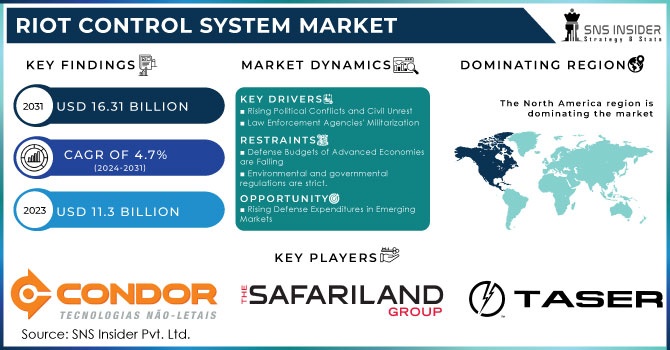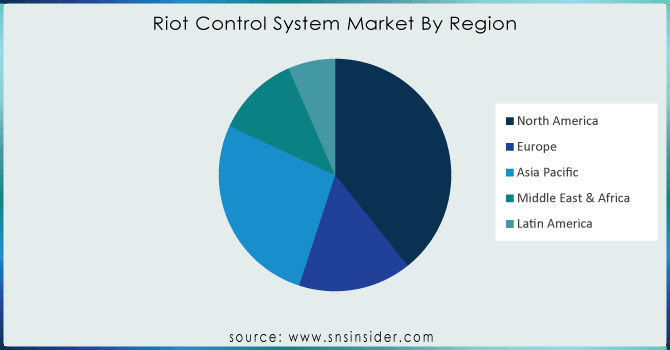Riot Control System Market Report Scope & Overview:

To get more information on Riot Control System Market - Request Free Sample Report
The Riot Control System Market Size was valued at USD 11.3 billion in 2023 and is expected to reach USD 16.31 billion by 2031 with a growing CAGR of 4.7% over the forecast period 2024-2031.
A riot control system is a mechanism for controlling, arresting, and dispersing participants in a protest, demonstration, or riot. When exposed to mucous membranes or skin, it contains substances such as tear gases, lacrimators, and irritants that induce extreme discomfort, burning sensations, and aches. Helmets, knee pads, riot shields, gas masks, neck protection, and body armour are also part of these systems. Riot control systems are classified as Defensive Weapons or Offensive Weapons according on the product. These systems include law enforcement and military troops tasked with preventing and controlling riots and other forms of public unrest.
Rising defence spending in emerging economies, as well as continued research and development of riot control systems, are projected to boost the market during the forecast years. Additionally, rising incidences of communal violence and protests around the world, as well as widespread adoption of technologically improved weapons and security solutions, are expected to enhance the market in the future years. Furthermore, control system integration with the cloud, the Internet of Things, and machine learning technologies are expected to drive the market in the next years.
MARKET DYNAMICS
KEY DRIVERS
-
Rising Political Conflicts and Civil Unrest
-
Law Enforcement Agencies' Militarization
RESTRAINTS
-
Defense Budgets of Advanced Economies are Falling
-
Environmental and governmental regulations are strict.
OPPORTUNITIES
-
Rising Defense Expenditures in Emerging Markets
CHALLENGES
-
Less lethal weapon trafficking and indiscriminate use
IMPACT OF COVID-19
The Covid-19 epidemic had an impact on the demand and availability of riot control equipment. Lockdown around the world, supply chain disruptions, and fluctuating raw material supplies prompted firms to shut down output, resulting in an undesirable fall in market growth. The introduction of vaccines to combat the Covid-19 pandemic is likely to boost market growth throughout the forecast period.
Riot control equipment is unique gear worn by Special Forces and law police during a riot. Body armour, a face visor, a riot helmet, a riot shield, and a gas mask are all worn by Special Forces and law enforcement officers. Riot police use non-lethal weapons like pepper spray, tear gas, and water cannons.
The market is divided into two categories: defensive weapons and offensive weapons. The section Offensive Weapons is predicted to have the biggest market share. The growth of microwave-based weaponry and laser technologies such as pain ray weapons and active denial systems can be ascribed to the factors.
The market is divided into two segments based on application: law enforcement and military. During the estimated period, the Law Enforcement category is expected to have the greatest CAGR. The variables can be linked to an increase in civil wars, conflicts, and political violence around the world.
The law enforcement sector segment is estimated to lead the global market in terms of revenue over the forecast period, owing to increasing adoption of safety devices with sophisticated technology in law enforcement and increased investment in this area, which is a factor driving global market expansion.
Rising civil unrest and political tensions are important factors driving the worldwide riot control system market. Growing regional violence is another aspect driving worldwide market expansion. Upgrading the law enforcement and defence industries is also expected to help the target market expand. In addition, the militarization of law enforcement organizations is projected to drive growth in the worldwide riot control system market in the near future.
Government regulations and environmental concerns about the use of chemical riot control systems, on the other hand, could stifle expansion in the global riot control system market. Furthermore, defence budget cuts in wealthy countries are a tough aspect that is projected to hinder global market growth. Nonetheless, R&D operations for the development of more efficient non-lethal weaponry have the potential to provide profitable prospects for the leading players in the worldwide riot control systems market.
KEY MARKET SEGMENTATION
By Technology
-
Electromagnetic & Sonic Weapons
-
Kinetic Impact Weapons
-
Chemical Agents & Others
By End User
-
Law Enforcement
-
Military
By Product
-
Offensive Weapons
-
Defensive Weapons
REGIONAL ANALYSIS
North America provides for the majority of revenue and is predicted to continue this position during the forecast period. The rapid adoption of new technology, as well as the existence of major players, are driving the growth of the riot control systems market in this area.
The Asia Pacific market is expected to grow rapidly in terms of revenue in the near future, followed by the Middle East and Africa. Growing budget allocation for military and law enforcement sectors, particularly in emerging economies, is one reason driving growth in the Asia Pacific region's target market. Furthermore, the rising use of non-lethal weapons for riot control is likely to drive up demand for riot weapon systems in this region.

Need any customization research on Riot Control System Market - Enquiry Now
REGIONAL COVERAGE:
-
North America
-
USA
-
Canada
-
Mexico
-
-
Europe
-
Germany
-
UK
-
France
-
Italy
-
Spain
-
The Netherlands
-
Rest of Europe
-
-
Asia-Pacific
-
Japan
-
south Korea
-
China
-
India
-
Australia
-
Rest of Asia-Pacific
-
-
The Middle East & Africa
-
Israel
-
UAE
-
South Africa
-
Rest of Middle East & Africa
-
-
Latin America
-
Brazil
-
Argentina
-
Rest of Latin America
-
KEY PLAYERS
The Major Players are Taser International Manufacturing Company, Combined Systems Inc., The SAFARILAND Group, Amtec Less Lethal Systems Inc., Condor Non-lethal technologies, BAE Systems, Taser International, Lrad, Raytheon, Eagle Industries, and other players
| Report Attributes | Details |
|---|---|
| Market Size in 2023 | US$ 11.3 Billion |
| Market Size by 2031 | US$ 16.31 Billion |
| CAGR | CAGR of 4.7% From 2024 to 2031 |
| Base Year | 2023 |
| Forecast Period | 2024-2031 |
| Historical Data | 2020-2022 |
| Report Scope & Coverage | Market Size, Segments Analysis, Competitive Landscape, Regional Analysis, DROC & SWOT Analysis, Forecast Outlook |
| Key Segments | • By Technology (Electromagnetic & Sonic Weapons, Kinetic Impact Weapons, Chemical Agents & Others) • By End User (Law Enforcement, Military) • By Product (Offensive Weapons, Defensive Weapons) |
| Regional Analysis/Coverage | North America (USA, Canada, Mexico), Europe (Germany, UK, France, Italy, Spain, Netherlands, Rest of Europe), Asia-Pacific (Japan, South Korea, China, India, Australia, Rest of Asia-Pacific), The Middle East & Africa (Israel, UAE, South Africa, Rest of Middle East & Africa), Latin America (Brazil, Argentina, Rest of Latin America) |
| Company Profiles | Taser International Manufacturing Company, Combined Systems Inc., and The SAFARILAND Group, Amtec Less Lethal Systems Inc., and Condor Non-lethal technologies, BAE Systems, Taser International, Lrad, Raytheon, Eagle Industries, and other players. |
| DRIVERS | • Rising Political Conflicts and Civil Unrest • Law Enforcement Agencies' Militarization |
| RESTRAINTS | • Defense Budgets of Advanced Economies are Falling • Environmental and governmental regulations are strict. |

